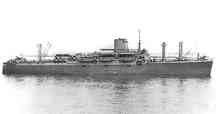He
only shared his stories with me
I Remember Grandpa By
James McConnell |  James H. Dowd
James H. Dowd
Click image for a larger view |
Introduction
My research for this began many years ago with
Grandpa advising me how to properly deploy my green plastic army men on a round
marble table. It continued by asking for and listening to Grandpa’s stories.
It now includes not only his stories but internet research, books, his
World War Two papers and an interview with Warren Reiter, a lieutenant who served
with and shared a tent with him from Louisiana
to New Guinea. I have included Grandpa’s statements where
possible. Most of these statements are
from my memory but some are from his actual words that were documented by the
Army. The introduction will give an outline
of Grandpa’s service and put it alongside historical dates.
Grandpa’s military career began in 1936 and ended
with his discharge in 1946. He went from the regular Army to the Wisconsin
National Guard to being inducted into Federal service for World War Two.
During World War Two he served in the 32nd Division.
This Division was known as the Red Arrow Division.
The Red Arrow Division dated back to World War One and were named “Les
Terribles” by the French. He rose from
a lowly private to the rank of Captain in the span of five years. His military service took him from Wisconsin to New Guinea and practically every place
in between. He spent 32 months overseas
in Australia, New Guinea, and the Philippines. In New Guinea he served under General
Douglas MacArthur and fought the Japanese 18th Army under General Adachi.
It was General MacArthur’s leapfrog tactics that led to some of the fiercest
fighting of the South Pacific at Aitape. It
is here that 15,000 Japanese who had been cutoff at Wewak counterattacked along
the Driniumor River.
It is also here where Grandpa was wounded. Grandpa and the 32nd Division obtained
many firsts during the war. He was one
of the first soldiers to have live ammunition fired over his head during training.
The 32nd Division was the first U.S. Division to embark for
overseas combat in one convoy after Pearl Harbor. It was the first to fight an offensive action
against the Japanese in the Southwest Pacific.
It was also the first to employ General MacArthur’s strategy of leapfrogging.
The convoy he embarked in from San
Francisco was escorted by the cruiser USS Indianapolis
(CA-35). [1] The convoy was scheduled to land on the north
coast of Australia but was
diverted to the south of Australia
by the Battle of the Coral
Sea. This was the first naval
battle where the enemy ships never saw each other.
Grandpa
engaged in combat operations against the Japanese and was wounded in battle. He returned to the United States after being wounded.
He was transferred to different hospitals as he recovered and was qualified
as an escort officer for convoy duty. He
spent the last days of World War Two transporting fresh troops to the Philippines.
Grandpa
originally joined the regular Army in 1936. He was assigned to the 3rd Infantry Division
at Fort Snelling, Minnesota.
Records show that Grandpa attended classes such as Infantry signal communications,
Combat intelligence, Organization of the Army and Organization of the Infantry.
He completed the Post Communication
School with an average score
of 96.2. Field training was done at Camp
Ripley, Minnesota.
Grandpa attained the rank of Private First Class. He stayed with the 3rd Infantry until
he was discharged on January 20, 1939.
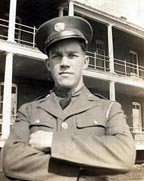 in
the 1930s
in
the 1930s
Click image for a larger view |
On November 2, 1939 Grandpa enlisted in the Wisconsin National Guard.
He was assigned to Headquarters Battery of the 120th Field Artillery
Battalion (FA BN) of the 32nd Division. The Division was made up of the Wisconsin and Michigan
National Guard. On October 15, 1940 the
32nd Infantry Division was called to active duty and federalized.
Grandpa was promoted to Tech Sergeant. During 1940 the 32nd
Division was transferred to Camp Beauregard
near Alexandria, Louisiana. [2] Due to the lousy conditions, soldiers nicknamed
it “Camp Disregard.” Here at Camp Beauregard Grandpa continually
trained for the war in Europe. On February 1, |
1941 Grandpa was promoted to Master Sergeant.
During the same month Grandpa and the 32nd Division were relocated
to Camp Livingston, Louisiana.
Here Grandpa and Lt. Reiter were part of the basic training cadre for the new
recruits of the 32nd Division. It
was at Camp Livingston
that Grandpa received word he was going to be promoted to 2nd Lieutenant. Grandpa realized that when he promoted to Lieutenant
he would lose all of his enlisted leave time and not get any more.
With the Army preparing for war Grandpa knew there would be no leave time
for officers. Grandpa finagled a ten day pass to go home to
Superior and “skipped”
out before he promoted. Lt. Reiter stated
that Grandpa’s Commanding Officer was so mad at Grandpa that when Grandpa returned
to base he made him wait in the hallway for an hour. Grandpa was finally brought
into the office and it was here at Camp Livingston
that Grandpa was commissioned as an officer and promoted to 2nd Lt.
on May 28, 1941.
| It was reported in the 32nd
Division newsletter dated June 2, 1942 that Master Sergeant James H. Dowd was
promoted from Master Sergeant to 2nd Lt.
[3] During August and September of 1941 Grandpa
and the 32nd Division participated in the Louisiana Maneuvers. Grandpa was part of Blue team. These were the greatest peacetime maneuvers
in U.S. Army history. The “Big One” as
it was called encompassed a maneuver area of over 3400 square miles and involved
over approximately 500,000 soldiers. These
maneuvers were to be a trial run for the war in Europe.
The 3rd Army under General Krueger was on the offensive against the
2nd Army. The
32nd Division part of Blue Team and the 3rd Army under General
Krueger were declared the winner.
|  in 1941
in 1941
Click image for a larger view |
Having accepted commission as an officer, Grandpa was
selected to attend the 3rd Army Junior Officer
Training Center,
Field Artillery at Camp Bullis [4] in San
Antonio Texas. Grandpa
attended school here from November 10, 1941 till December 20, 1941.
Grandpa called it, “General Krueger’s School
of Killer Knowledge.” It was the first time that American troops fired
live ammunition over the heads of each other in training. Grandpa took courses in leadership and field
tactics. Close order drill and or calisthenics
began each day except Saturday. Tactical
problems lasted a full five days. Saturday was not a day off. It was used for inspections and preparing for
the following week. It was here on December 7, 1941 Grandpa learned that Pearl Harbor had been bombed by the Japanese. On Monday December 8, 1941 at 12:29 PM, President
Roosevelt at a joint meeting of the House and Senate, asked for and received a
declaration of war against Japan.
Grandpa
rejoined the 32nd Division at Camp
Livingston, still assigned
to the 120th FA BN.
In February 1942 the Division moved to Fort Devens,
Mass. in preparation to be shipped to Northern
Ireland to join the war in Europe.
At Fort Devens
replacement soldiers from all over the United States brought the Division
up to full combat strength. With the armed
forces of Japan driving towards
Australia and New
Zealand, the decision was made to send the Division
to the South Pacific. The Division was being sent to defend these
countries whose troops were fighting the Germans in the Middle
East. On March 25, 1942
the Division was notified it was being sent to Australia. Grandpa and the rest of
the soldiers loaded up on trains and were rushed “high priority” across the United States to San Francisco.
During
February of 1942 General Edwin F. Harding took command of the 32nd
Division. The Division would become part
of I Corps in Australia
under General Robert Eichelberger. General
Douglas MacArthur arrived in Australia March 17, 1942 and on the
orders of President Roosevelt took over the newly created Southwest Pacific Area
(SWPA), which included I Corps. The 32nd
Division would soon come under the control of General MacArthur.
On
April 22, 1942 the Division departed San Francisco
as an eight ship convoy in route to Brisbane Australia. Leaving San
Francisco was an area called
the “Potato Patch.” This area had such rough seas that ninety percent
of the soldiers became sick. The convoy
was escorted by the lone cruiser USS Indianapolis. Grandpa was on board the USS Ancon (AP-66).
The Ancon was one of the smaller ships in the convoy and the soldiers called it
a “raft with portholes.”
| USS Ancon
Click image for a larger view |
During the convoy Grandpa stated that it seemed
like every man aboard was seasick. Grandpa stated that breakfast would be served
and the vomiting would begin. Lunch and
more vomit. Dinner and more vomit. To make
matters worse the soldiers had to pass through the latrine to get to the mess
hall. To get away from the stench Grandpa
stated that he spent a majority of his time on the deck. On April 30th, 1942 Grandpa and the
convoy |
crossed the equator.
As the convoy neared Australia,
the escort ship USS Indianapolis left the convoy to assist in the Battle of the Coral Sea. The convoy was rerouted to the south to avoid
the battle of the Coral Sea and escorted to Australia by several frigates of the
Royal Australian Navy. The convoy arrived
at Adelaide Australia on May 14, 1942. Grandpa and the Division established themselves
at Camps Woodside and Sandy
Creek. In July of 1942 Grandpa traveled by rail to
Camp Cable which was located south of Brisbane Australia..
| Once at Camp Cable Grandpa and the
32nd Division spent a majority of their time training for the coming
invasion of New Guinea. Grandpa was assigned to Battery B of the 120th
Field Artillery battalion. The training
focused on, marksmanship, tactical field artillery training and beach landings
with artillery pieces. These beach landings
were conducted with Navy LSTs (Landing ship tank) in preparation for the upcoming
landings in New Guinea.
Grandpa had some time for relaxation. Lt.
Reiter stated that while on pass Grandpa spent a |
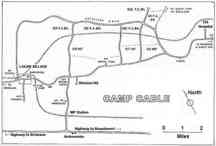 Camp
Cable located near Brisbane. Note location of 120th F.A. BN.
Camp
Cable located near Brisbane. Note location of 120th F.A. BN.
Click image for a larger view
|
majority
of his free time at the beaches of Australia. They would rent a beach house in the area of
Coolangatta Australia
[5] for the weekend
with three or four guys and spend their time drinking, swimming in the ocean and
going to the movies He stated Grandpa’s favorite activity was swimming in the
ocean. He said on Saturday nights at Camp
Cable they would get a case
of Australian beer. The Australian beer
was packed in straw and it took two men to carry a case. At Camp
Cable they would watch movies
in an outdoor theater. If it rained the
projector was put in a tent and the soldiers would put on their helmets and rain
gear and watch the movie in the rain. Being Catholic Grandpa and Lt. Reiter also
went to church. Grandpa also took sightseeing
trips into Brisbane. Grandpa took a great number of pictures in Australia. Lt. Reiter stated that the officers in the 120th
FA BN were all very friendly. He stated
they liked to have fun and found it wherever they could, even later in New
Guinea.
| On September
13, 1942 General MacArthur announced he was sending the 32nd Division
to New Guinea. When a portion of the Division shipped out for
the invasion of Buna, New Guinea, Grandpa and Lt. Reiter stayed behind
in Australia
and continued training. During January
of 1943 the United States 6th
Army was created in Australia
under the command of General Walter Krueger as part of SWPA. The 6th Army, under the command of
General Krueger included the 32nd Division.
In
late September of 1943 Grandpa and Battery B along with additional elements of
the Division were sent to Milne Bay
located at the southern tip of New
Guinea. They
stayed and trained at Milne Bay
| 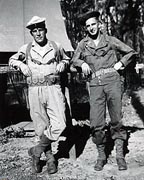 Having fun
in Australia Click image for a larger view
Having fun
in Australia Click image for a larger view |
for a month before going to
Goodenough Island New Guinea
in preparation for another landing on New Guinea. On Goodenough Island Grandpa and the rest of
the soldiers suffered sporadic bombing by Japanese aircraft including being bombed
on Christmas Eve. It was probably at Milne
Bay and here on Goodenough
Island that Grandpa learned a great respect for the
natives of New Guinea. Grandpa called them the “Fuzzy Wuzzies” and
respected them greatly for their work ethic. Grandpa
stated they did everything, native police, scouts, carried ammunition, equipment
and the wounded.
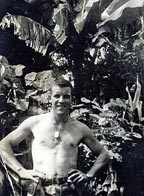 At Saidor
At Saidor
Click image for a larger view | On
December 17, 1943 the Sixth Army was tasked with the invasion of Saidor, New Guinea. This landing at Saidor was named the Michaelmas
Task Force. The capture of Saidor would
provide a blocking force from Japanese troops retreating from Finchaven and trap
an entire Japanese Division at Sio New Guinea. The 32nd Division was ordered to
capture Saidor to provide this blocking force.
D-Day was January 2, 1944. The invasion
was preceded by strong naval gunfire that softened the Japanese defenses. Grandpa was among the first wave of soldiers
who landed that day. Grandpa arrived on
the beach of Saidor in a LST. Thanks to the naval gunfire the landing at Saidor
was virtually unopposed by the Japanese. Once
in Saidor |
| Grandpa and the
120th Field Artillery supported the infantry with blocking the Japanese
retreat. Once Japanese positions were known Grandpa and
the artillery would fire their 105mm howitzers. During his time in Saidor Grandpa lived and
slept in a variety of locations. Some nights
he was able to sleep in a squad tent or a pup tent and some nights it was on the
ground in a foxhole. Grandpa ate C-rations
and occasionally fresh fruit. Grandpa and
the rest of the soldiers were allocated 3 cans of “C-Rats” a day.
Grandpa also contracted Dengue | 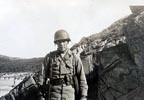 After the beach
landing
After the beach
landing
Click image for a larger view |
Fever while at Saidor.
Lt. Reiter stated that Dengue Fever was called the bone creaky disease
and when you got it you knew you had it. He
stated he felt stiff and weak until the medicine took effect.
No movement was allowed during the night. Grandpa stated that while in his foxhole at
night he would focus on a particular star in the sky.
If Grandpa observed a person move in front of that star, he would shoot.
During his time at Saidor, Grandpa would often go out with reconnaissance
platoon in order to direct artillery fire upon the Japanese.
Grandpa would act as a forward observer for the artillery to assist the
infantry. He would also go up in an airplane
called a Cub, look for the Japanese and direct artillery fire.
| 
A Cub airplane used by Grandpa and the 120th FA BN to direct artillery
fire is unloaded June 2, 1944 at the Saidor beachhead.
Click image for a larger view
|
During the early days of March a task force was being formed to make a landing
at the Yalau Plantation which was located about 30 miles west of Saidor. This landing and occupation of the area would
provide a base to intercept the enemy stragglers trying to escape from Finschaven
and avoid the Saidor area. Grandpa, Lt.
Reiter and Battery B along with additional forces of the 32nd made
an unopposed landing at the Yalau Plantation at 0735 Hrs on March 5, 1944.
Lt. Reiter stated that the plantation was “Headhunter territory.”
Lt. Reiter |
stated that the Headhunters kept their distance from the armed U.S.
troops. On April 14th troops
of the United States and Australia made
contact at Bogadjim, about 30 miles west of Yalau. This contact put the surrounding area firmly
in the hands of Allied control.
| On April 18, 1944 the 32nd
Division, as part of the Persecution Task Force under the command of General Jens
Doe departed Finschaven for Aitape. The first landing at Aitape took place on April
22. Grandpa and Battery B followed on May
1. The landing was unopposed by the Japanese.
This landing effectively trapped the Japanese 18th Army at Wewak, cutting
them off from supplies. On May 4th
General Gill took command of Persecution Task Force and the Aitape area.
Once in Aitape Grandpa and the rest were busy building defensive positions
along the Driniumor River.
General Gill commanded the Eastern Defense Area and General Clarence Martin
commanded the Persecution Covering Force, designated the Eastern |
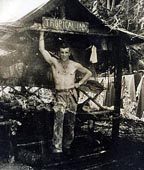 At Saidor
At Saidor
Click image for a larger view |
Defense
Command, which covered the line of defense along the west bank of the River.
American ULTRA intelligence sources put the Japanese 18th Army
under General Adachi attacking the American positions along the Driniumor
River in an attempt to break
out from Wewak. The 18th Army
had approximately 55,000 personnel of which about 15,000 were in the forward combat
area with approximately 5,000 front line troops. What intelligence could not tell
them was where the Japanese had begun to form along the Driniumor
River.
Additional American troops were brought into the area. This brought the
troop level in the Aitape area to more than two divisions. General Krueger formed the XI Corps under General
Hall to take command of the Aitape area. General Krueger ordered several reconnaissance
missions in an attempt to locate the Japanese troops. During the month of June
1944 Grandpa was promoted to Commander of Battery B. Warren Reiter was promoted to Grandpa’s Executive
Officer (XO).
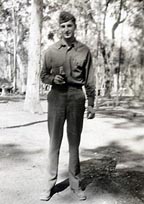 Lt. Reiter
Lt. Reiter
Click image for a larger view | During
the first part of July Grandpa was once again out with a reconnaissance patrol
with members of the 128th Infantry.
Grandpa and the squad set out across the Driniumor River
to try and find the Japanese. Grandpa and
his squad quickly found themselves behind enemy lines. The squad had two choices, the mountains of
New Guinea or
the coastline. They fought their way to
the coast for 2 days. Grandpa stated, “We
got down pretty close to the tail end our rations and we were drinking some pretty
slimy water doctored up with purification tablets to make a nauseating but safe
drink. On the third day as Grandpa and
the squad were walking on a beach trying to get back through enemy lines they
were able to make contact with a U.S. Navy
gunboat, who plucked them off the beach behind enemy lines.
(Warren Reiter recalled that in Battery B and the 120th FA, |
Grandpa and the squad getting caught behind enemy lines was a “big deal.”
He stated that nobody was sure where they were or what had happened to
them. Grandpa recalled that is was like the Japanese
lines had opened up and let them pass so as not to give away their positions and
then closed behind them.
Once
he got back Grandpa and Battery B and were put into defensive positions along
the Driniumor River near Afua. It is here along the Driniumor River
that Grandpa experienced the determined and ferocious attack of the Japanese 18th
Army. The Japanese began their attack of
the American lines along the River at about 10:00PM on the night of July 10th. The Americans were able to repulse the first
two waves of Japanese troops. Once alerted
to enemy positions, Grandpa and the artillery began firing on the Japanese troops.
The American artillery was fired so close to American troops that they
would duck their heads as the artillery passed over them.
American artillery then began firing on the Japanese troops trying to get
across the Driniumor. It was told that,
“The River flowed red from the blood of soldiers.”
The Japanese continued their attack and finally broke through the center
of the American lines. General Martin ordered
a night retreat from the River. General
Krueger believed the retreat was unnecessary and on the morning of July 12th ordered
General Hall to push the Japanese eastward back across the Driniumor.
General Hall in turn ordered General Martin to retreat no further and forbade
the withdrawal of any unit except in the face of overwhelming forces.
General Hall relived Martin of his command and placed General Gill in charge
of the Persecution Covering force and the Driniumor lines. Gill’s first order was a counter attack on July
13th to restore the Driniumor line. The counterattack succeeded and the Americans
again established a line along the Driniumor.
One of the stories Grandpa told was that he and another soldier were trying
to direct artillery fire against enemy positions from a foxhole. Japanese machinegun fire kept them in the foxhole.
Grandpa recalled that the other soldier decided to stand up to try and
getter a better view of the target. The soldier was immediately hit by machinegun
fire and fell back into the foxhole. Grandpa
stayed low and was able to drag the soldier back to the aid station.
By the time Grandpa and the soldier made it back to the aid station Grandpa
was covered in the soldier’s blood. Once
at the aid station medics began working on the soldier. One of the medics grabbed Grandpa and began
to try and provide him with medical assistance.
Grandpa tried to explain that he was not hit. The medic told Grandpa that he was in shock
and did not know he was hit. The medics
then proceeded to strip Grandpa naked, only to tell him that he was not hit. Grandpa later heard that the soldier lived and
was returned to the United
States. Grandpa
stated that when the artillery would explode along the river, he would have to
open his mouth so that his eardrums would not explode. Grandpa stated he got a lot of dirt in his mouth
this way.
While
in the Aitape area Grandpa was often out on patrol as a forward observer or artillery
liaison officer with one of the infantry battalions.
It was on one of these patrols that Grandpa shot a Japanese Officer.
Grandpa stated that he saw an enemy Japanese soldier crawling up a tree
to an advanced observation post. Grandpa stated, “I let him have two or three
shots from ‘Little Betsy” my carbine and that was all there was to it.” Grandpa knew it was an officer because when
he started to fall from the tree he saw the Officer’s sword.
General
Adachi realized that the Americans had reformed their lines and had begun to reinforce
the Afua area. General Adachi ordered his
20th Division to annihilate the enemy at Afua. The attack began on July 18th and
raged for two days. Both sides regrouped
on July 20th. It was here along
the Driniumor River
at Afua that Grandpa was injured. (Map Below)
On July 21, 1944 Grandpa was once again on the front lines as the artillery
liaison officer with Troop C of the 112th Cavalry. Troop C occupied the west flank of the American
lines at a place called “Tsuru” by the Japanese. Here the entire Japanese 79th
Infantry numbering seven hundred men
| and a sixty-man artillery company
with a single artillery piece would attack at 1600HRS.
The Japanese lone artillery gun began firing at Troop C. Grandpa positioned
himself under the root of a large tree (more than likely a mangrove tree) near
the headquarters tent of Troop C in attempt to direct artillery fire at the attacking
Japanese forces. The Japanese began firing
point blank at the headquarters tent. One the rounds landed in the tree branches above
Grandpa. A piece of shrapnel struck Grandpa
in the left foot severing his three middle toes. Grandpa stated that when he was hit, he felt
a sharp pain in his foot. He looked down
and saw blood on his boot. Grandpa attempted
to stand up but fell down. By this time
the Japanese 79th Infantry was inside Troop C’s perimeter.
However, due to the fog of war soldiers of both sides did not fire.
The Japanese because they assumed it was already under Japanese control
and the Americans did not fire because an American observation |
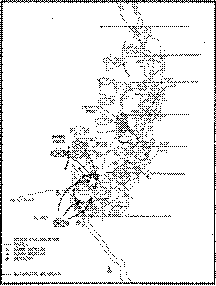
Driniumor
River
at Afua
Click image for a larger view
(very large for detail) |
plane reported that the Japanese were American soldiers entering their perimeter. Heavy firing would soon break out between Japanese
and American forces, but this temporary lull in the firing allowed Grandpa to
make his way back to squadron headquarters to receive medical treatment.
The Japanese continued their attack and encircled Troop C.
Heavy fighting would last four days until Troop C was relieved and able
to break out of the Japanese encirclement on July 25th. An estimated
9,300 Japanese troops had lost their lives in the Aitape area. While receiving
medical treatment at the aid station Grandpa contacted Warren Reiter and advised
him of his injuries. This is the last time
the two would speak.
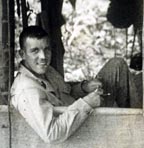 Click image for a larger view
Click image for a larger view |
Grandpa was evacuated to the 5th Portable
Hospital at Aitape where
he stayed for two days while receiving treatment for wounds to his left foot.
He was then transferred to the 237th Station
Hospital at Finschaven,
New Guinea. [6] On July 24th while in Ward 4, he
was awarded the Purple Heart for his injury. Here
on August 8, 1944 Grandpa had surgery to amputate the 2nd, 3rd
and 4th toes on his left foot. Grandpa was then transferred to the 4th
General Hospital at Finschaven. Grandpa was promoted to Captain on August 16,
1944. On October 27 Grandpa was sent home
to the |
United
States for medical treatment.
He arrived at Madigan eneral Hospital
in Tacoma Washington
and remained here for ten days receiving further treatment. On November 28, 1944 he was transferred to Percy Jones General
Hospital in Battle Creek Michigan.
[7] Grandpa received a thirty day pass and on Sunday
December 24, 1944 Grandpa arrived home in Superior (1508 Thirteenth St) for the first time in
3 years. Once his thirty day pass was
over he reported back to Percy
Jones Hospital
for further treatment. On January 30th,
1945 Grandpa appeared before the Disposition Board at Percy Jones and was placed
on permanent light duty. Grandpa was transferred
to the Army Ground Force Replacement Depot at Fort Meade, Maryland.
[8] On April 30th, 1945 Grandpa was qualified
as an escort officer for convoy duty.
Grandpa
was transferred to Fort Adair
Oregon on July 5 1945 and given what Grandpa
called one of his greatest problems of the war.
Grandpa had to escort 100 18 year old fresh recruits from Brooklyn, New York to the
Philippines. On August 3rd Grandpa and the new recruits departed
Adair Oregon by train and on August 5th
arrived at Camp
Anza [9] near Riverside
CA. Camp Anza
was the staging area for the Los Angeles Port of Embarkation (LAPE). Grandpa stated the troops were always getting
into trouble. Grandpa stated he organized
boxing tournaments to keep the troops busy. Grandpa stated that by the time he got the troops
on board the ship, 35 of them had court-martials. (Once on board ship he dismissed
all the charges.) Grandpa was here on
August 6th when Hiroshima was bombed
and on August 9th when Nagasaki was bombed. Grandpa stated he was in Los Angeles on August 14th when the
Japanese Emperor Hirohito ended the War by accepting the Allies’ terms of surrender.
Grandpa
still had a job to do and on August 25th he along with the New
York recruits departed Long
Beach, CA (LAPE) on board the USS Broadwater (APA-139).
Grandpa was on board the Broadwater on September 2, 1945.
That morning in Tokyo Bay
on the decks of the USS Missouri, Japan
and the United States
formally signed the Instruments of Surrender ending World War II.
[10] Grandpa arrived in the Philippines with
the fresh troops on August 25th. These troops would go on to become part of the
Japanese occupation force.
On
September 9th Grandpa departed the Philippines
and arrived in San Francisco
on September 26th. Grandpa stated
while in San Francisco
he and a couple other officers decided to celebrate by going to a nice restaurant
for dinner and a good steak. He said during
dinner one of the employees dropped some dishes making a loud noise and he and
the other officers “hit the deck”. He said the other customers were staring at
them as they were laughing and getting back into their seats.
Grandpa
returned to Fort Adair
until October 13, 1945 then transferred to Camp
Beale Separation
Center in Northern
California. On December 8,
1945 Grandpa had a physical examination at Oakland Regional
Station Hospital
in preparation for retirement from the service.
Grandpa was 28 years old and reported as being 69 ½ inches tall and 169lbs.
The report stated a deformity to left foot, amputation middle 3 toes.
On
December 10 Grandpa appeared before the Army Retiring Board for Officers also
at Oakland Hospital. In the proceeding which lasted 20 minutes two
doctors testified to Grandpa’s injury. Grandpa
first testified that he desired to be relieved from active duty.
Grandpa stated his reason, “I feel that I can make a better living for
myself on the outside and that my service in the Army has gone as far as I care
to take it.” Dr. Kahlstrom testified that Grandpa was permanently
incapacitated for active service due to his injury incurred against enemy action.
Dr. Gaiser then testified that he agreed with Dr. Kahlstrom.
When asked if he knew what civilian occupation Grandpa intended to enter
Dr Gaiser stated, “On leaving the Army, he anticipates going into a business of
his own, preferably a dry-cleaning establishment.”
The board found that, “Captain James H. Dowd is permanently incapacitated
for active service.”
Grandpa
was granted leave time and went back home to Superior. Grandpa had served almost 10 years in the Army
and 2 ½ years overseas. He was formally
discharged from the Army on April 14, 1946. When he discharged be began receiving his retirement
pay of $172.50 a month. Seven months later
on November 28, 1946, Grandpa and Grandma were married in Superior.

Acknowledgements
This
work could not have even started were it not for Grandpa.
He saved everything from his time in the military.
He saved every scrap of paper, certificate and notebook.
You name it and he saved it from this period. Grandpa also took and had a lot of pictures
taken of him and where he had been. By
piecing together the different reports, dispatches and military forms I was able
to track Grandpa’s movements to the day and in some cases down to the hour.
Grandpa was also kind enough to tell me his stories around the kitchen
table whenever I asked. Grandpa’s statements were from these stories,
newspaper articles and official Army documents.
Warren
Reiter brought life to this project and it all came together with one phone call
during the summer of 2005. I had placed an advertisement in the 32nd
Division newsletter and like a gift Colonel Warren Reiter called. His first words were,” I served with Jim, your
Grandfather.” Warren went on to tell me countless stories
about Grandpa. I called him numerous times
and continue to call him. Each time I call
him he is always helpful and remembers new stories. His memories of Grandpa and the little things
Grandpa did during this time are incredible. When
Grandpa was wounded Warren Reiter became Commanding Officer of Battery B, 120th
FA Battalion. He served in New
Guinea, the Philippines
and became part of the Japanese Occupation Force. He made the military a career and retired after
35 years with the Regular Army and the Wisconsin National Guard as a Colonel.
Today Colonel Reiter lives in Colorado Springs with his
wife

Grandpa’s
Army Serial #0 411 577
Decorations:
-
Purple Heart
- Asiatic Pacific
Theater Ribbon
- Victory
Medal WWII
- American Defense
Medal
- American Theater
Ribbon
Service
outside US: Served 32 months overseas
in Pacific Theater
4-22-42
Departed San Francisco.
Arrived Adelaide Australia 5-14-42
10-27-44
Departed 4th General Hospital New Guinea. Arrived United States 11-16-44
8-25-45
Departed Long Beach.
Arrived Philippines 9-15-45
9-22-45
Departed Philippines. Arrived San
Francisco 9-26-45
Battles:
New
Guinea GO 33 WD 1945
11-2-39
Grandpa enlisted in the HQS Battery 120th Field Artillery, Wisconsin
National Guard.
3-16-40
promoted to Corporal.
7-20-40
promoted to Sgt.
10-15-40
Grandpa promoted to Tech Sgt. The 32nd Division was inducted into
Federal Service under order of President Roosevelt.
2-1-41
promoted to Master Sgt.
5-28-41
promoted to 2nd Lieutenant while at Camp Livingston, LA.
11-10-41
through 12-20-41 attended the 3rd Army Jr. Officers Training Center
Field Artillery Camp Bullis, Texas
4-30-42
11:32AM crossed the Equator on board the U.S.S. Ancon
7-16-42
Qualified as 120th FA BN 32nd Infantry Division Unit Gas
Officer
1-15-43
Promoted to 1st Lieutenant
7-21-44
Injured at Afua, New
Guinea.
8-16-44
Promoted to Captain.
4-14-46
Discharged from the Army.

Sources
of Interest
Books:
Kahn,
E.J. G.I. Jungle. New York, New York:
Simon and Schuster, 1943.
Drea,
Edward. Leavenworth Papers
Defending the Driniumor. Fort Leavenworth, Kansas:
Combat Studies Institute, 1984.
Websites:
“The
32nd Red Arrow Veterans Association”
http://www.32nd-division.org/
“Camp
Cable.”
http://home.st.net.au/~dunn/ozatwar/campcable.htm
Garbo,
Bill. “Dog Platoon at Driniumor
River”
http://www.kilroywashere.org/003-Pages/BillGarbo/BillGarbo.html
McCracken,
Jim. “Return to Driniumor”
http://www.kilroywashere.org/009-Pages/JimMcCracken/JimMcCracken.html
Wallesch,
Shayne. “1942 Troop Ship Crossings.”
http://troopships.pier90.org/

To
return to where you started, click the end note number again.
To
return to top of page, click the star . . .



